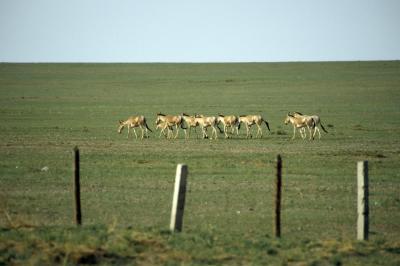The Gobi-Steppe Ecosystem is world renowned for its populations of migratory ungulates, which cover great distances in search of forage. Researchers at the Research Institute of Wildlife Ecology at Vetmeduni Vienna have documented, that in just one year an individual wild ass can range over an area of 70,000 km2. "Wild asses and gazelles have to be permanently on the move and travel very long distances to find enough food. Rainfall is highly variable in this region. As a consequence pastures are patchy and unpredictable in space and time," explains Petra Kaczensky, one of the authors from the Vetmeduni Vienna.
Barriers to migration
Although vast stretches of land remain largely unaltered, migratory species face a number of obstacles that disrupt their journey and affect their ability to survive and reproduce in this highly variable environment. The main obstacles of the recent past are fences erected along the international borders with Russia and China and the Trans Mongolian Railroad. The railroad fence now constitutes the de facto eastern border for the Asiatic wild ass, cutting the population off from its former much larger range to the east. Gazelles have also been largely restricted to either side of the railroad, but when they do attempt to cross they often get entangled or turned away. On its rapid path of economic development, Mongolia continues to build roads and new railway lines that are expected to threaten the ecological phenomenon of wildlife migration, if not carefully planned for.
Science can inform regional planning
Structural modifications could be made to fences, unnecessary fences could be removed in areas where there are no livestock, and planned railway lines could be re-routed to avoid sensitive areas. "We advocate a development process that minimizes negative effects on the integrity of the ecosystems such as following existing roads between villages to avoid large uninhabited regions while also incorporating the necessary designs so that they do not become new barriers; at the same time known barriers need to be removed," says corresponding author Kirk Olson from Fauna & Flora International, a global conservation organization based in the UK. "Regional planners need to think big - meaning on the scale of the migrations," adds author Nyamsuren Batsaikhaan from the National University of Mongolia.
A responsibility to link science and policy
Research into the movement and habitat requirements of the species roaming Mongolia´s Gobi-Steppe Ecosystem is ongoing, but needs to continue to identify potential conflicts between development efforts and biodiversity conservation requirements. Science can and should play a role in planning processes, according to Chris Walzer of the Vetmeduni Vienna, another author of the paper. "It is also among the responsibilities of a university to provide that link between science and policy making. Scientists can provide constructive inputs in fields such as wildlife management and conservation," Walzer emphasizes. "I think that if we do not translate our findings into practical advice that non-scientists can use, we have failed in our educational mission." In the case of Mongolia, the authors are hopeful that joint efforts will lead to the preservation of the country´s outstanding natural heritage for future generations.

Mongolian wild ass are among the most mobile of terrestrial mammals, ranging over thousands of square kilometers each year.
(Photo Credit: Photo: Petra Kaczensky / Vetmeduni Vienna)